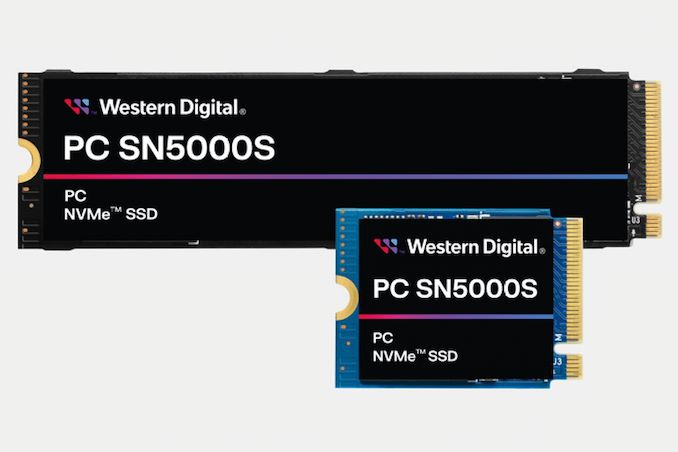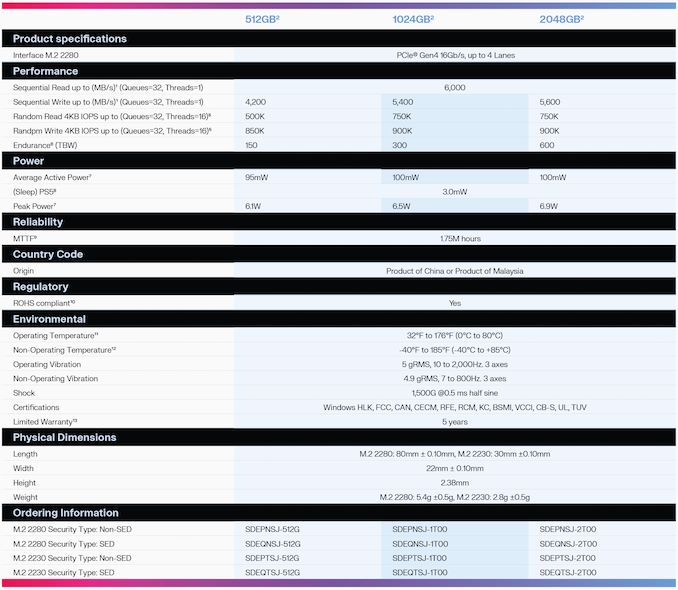Western Digital Launches PC SN5000S SSD: Low-Cost Meets High Performance
by Anton Shilov on March 14, 2024 1:00 PM EST- Posted in
- SSDs
- Storage
- Western Digital
- 3D QLC
- Kioxia
- WD SN5000S

Western Digital has introduced its new series of SSDs aimed at mainstream PCs, which combine high performance and low cost. The Western Digital PC SN5000S family of DRAM-less drives uses the company's 3D QLC NAND memory and an in-house-developed platform, so the SSDs promise to be relatively inexpensive. Meanwhile, their sequential read performance reaches 6,000 MB/s.
Western Digital's PC SN5000S drives are based on the company's latest in-house controller, which supports a PCIe 4.0 x4 host interface and BICS6 3D QLC NAND memory. The controller fully supports Western Digital's nCache 4.0 HybridSLC technology with endurance monitoring to ensure decent performance, RSA-3K and SHA-384 encryption, and TCG Opal 2.02 and Pyrite security capabilities.
On the capacity side, Western Digital's PC SN5000S drives will be available in 512 GB, 1 TB, and 2 TB configurations. As for performance, the 2TB PC SN5000S is rated for up to 6,000 MB/s sequential read speed, up to 5,600 MB/s sequential write speed, up to 750,000 random read IOPS, and up to 900,000 random write IOPS. The SSDs will be available in M.2-2230 and M.2-2280 form factors.
| Western Digital SN5000S SSD Specifications | |||
| Capacity | 512 GB | 1 TB | 2 TB |
| Controller | Western Digital's proprietary controller | ||
| NAND Flash | Western Digital / Kioxia BiCS 6 176L 3D QLC NAND | ||
| Form-Factor, Interface | Single-Sided M.2-2280, PCIe 4.0 x4, NVMe 2.0 | ||
| Sequential Read | 6000 MB/s | ||
| Sequential Write | 4200 MB/s | 5400 MB/s | 5600 MB/s |
| Random Read IOPS | 500K | 750K | |
| Random Write IOPS | 850K | 900K | |
| Peak Power | 6.1W | 6.5W | 6.9W |
| SLC Caching | Yes | ||
| Security Capabilities | TCG Opal 2.02 and Pyrite | ||
| Warranty | 5 years | ||
| Write Endurance | 150 TBW | 300 TBW | 600 TBW |
When it comes to endurance, Western Digital rates 2TB PC SN5000S at 600 terabytes to be written, 1TB version at 300TBW, and 512GB at 150TBW, which is significantly lower compared to entry-level SSDs with similar capacities (yet higher compared to WD Green-branded drives).
While the performance of Western Digital's PC SN5000S hardly impresses our avid readers, who tend to look at the highest-end SSDs, 1TB and 2TB versions offer considerably higher performance than most entry-level drives on the market today. What disappoints is the relatively low endurance of Western Digital's new SSDs compared to entry-level drives from other makers.
Western Digital primarily markets its PC SN5000S solid-state drives for OEMs, where they succeed the company's SN740-series. For PC makers, the drives are fast enough, and perhaps more importantly, they support advanced encryption technologies as well as TCG Opal 2.02 and Pyrite security capabilities, which is crucial for desktops and laptops sold to various U.S. government agencies.
Source: Western Digital











11 Comments
View All Comments
artifex - Thursday, March 14, 2024 - link
Since you've stated the line is low-cost, please share that pricing information.PeachNCream - Thursday, March 14, 2024 - link
Goodness, stop setting such a high bar for pipeline articles. Most of them are just press releases with a dash of generic commentary. Just wait a bit and read AT's in-depth publications like their detailed GPU reviews or deep CPU architecture analysis work if you want extensive content.meacupla - Thursday, March 14, 2024 - link
600TBW for 2TB model is very low.That's half of what the SN770 does at the same capacity.
It's also disappointing they don't have a 4TB model.
Samus - Thursday, March 14, 2024 - link
The lack of 4TB model shocked me too...that's pretty common among QLC and even TLC drives now with the insane layer density of NAND. It certainly isn't a demand decision so it's probably a supply decision. Corsair, Crucial, Samsung, etc all have 4TB options in their entry-level drives. The Crucial P3 is the one to beat for price imho. Meanwhile Hynix has no 4TB drives that I know of, and WD have many 4TB drives in the Blue and Black line that aren't much more expensive than the P3, so this really seems like a missed opportunity.wr3zzz - Thursday, March 14, 2024 - link
In 3 years since I have PCIe 4.0 SSD I have experienced exceeding 300MB transfer rate probably less than 90 minutes in aggregate. 99% of my disk activities involve files too small to engage in sequential transfers involving files in the GBs.Dizoja86 - Friday, March 15, 2024 - link
......good for you? Why did you feel the need to share your usage details? Not everything is going to be made for you, although if you're operating with a lot of small files, the high IOPS of higher end drives may still benefit you.wr3zzz - Friday, March 15, 2024 - link
...Is it though? Glad you transfer large videos or databases all day long but most people don't. The performance matrix of PCIe 4.0 SSD or soon PCIe 5.0 SSD is one of those mind boggling numbers just don't translate well into real world performances due to how Windows handle files.Dante Verizon - Friday, March 15, 2024 - link
QLC ? YuckSamus - Friday, March 15, 2024 - link
I couldn't tell you exactly how many Intel 660\670 QLC SSD's we have deployed at one client, but it's in the hundreds, mostly 1TB drives but some are 512GB. Zero failures, zero health issues, and while these are basic office PC's and laptops, we are still talking Outlook mailboxes - some OST's exceeding 50GB - and large 100-200GB locally cached OneDrive libraries. It's remarkable how well QLC holds up, and how well the HMB works. Though the 660\670P have a tiny 256MB DRAM cache it is exclusively used to buffer the live indirection table out of the SLC cache.The spiritual successor, the Solidigm P41 Plus, is essentially identical with some firmware tweaks to support the Hynix-engineered NVMe driver (which ironically works with the 670P in the Solidigm toolbox.)
Great everyday drives. If you copy a terabyte of data to your computer daily it isn't for you but if working with 100GB of daily changes, it would take a minimum of 10 years to hit the 370TB endurance rating. Most user average workloads have 10-20GB of daily writes, meaning these drives would take 50-100 years to hit 370 TBW. A century.
ceisserer - Saturday, March 16, 2024 - link
> I couldn't tell you exactly how many Intel 660\670 QLC SSD's we have deployed> Zero failures, zero health issues,
Funny I had exactly the opposite experience. I owned a 660P/1TB and after 1 year of use (mostly linux, but dual boot linux/windows only light workload) I noticed sometimes visual studio builds would be extremly slow - windows task manager showed me the 660P write at 20-30mb/s and was 100% busy. Small spikes in between, but also those very slow phases.
And recently one of my students complained about his laptop's poor performance running docker. Task manager showed SSD busy 100% with just 5-20mb/s write throughput. And device manager revealed it was a 512GB 660p.
So contrary to your experience I met that type of drive only twice, and in both cases - despite reporting great health via SMART - the 660s showed extremly degraded write performance. And yes, both machines had TRIM enabled...